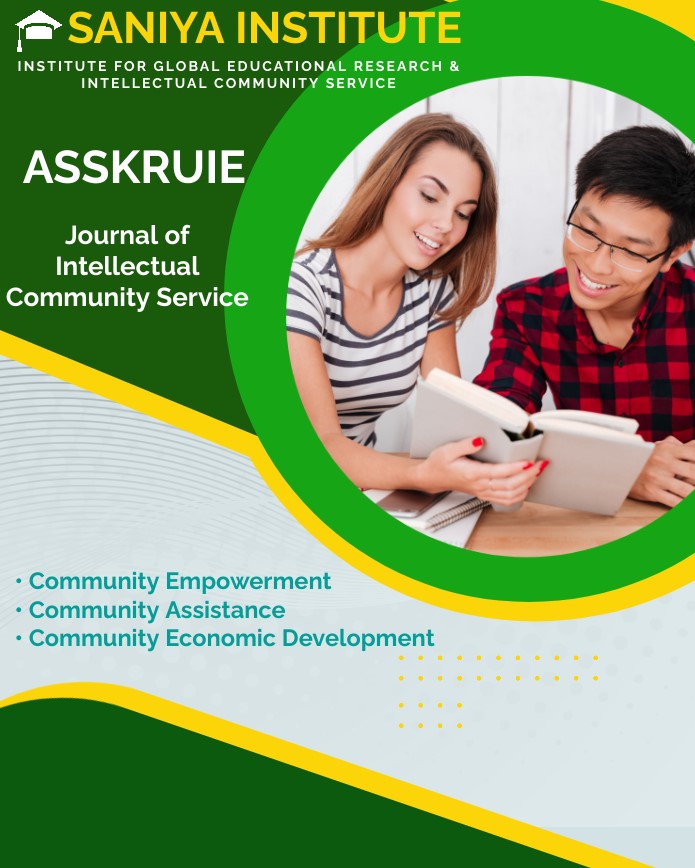Assistance in the Implementation of Eid al-Adha 1446 Hijriah According to Islamic Law in Nilagraha Housing, Gonilan Village, Kartasura District, Sukoharjo Regency, Central Java
Keywords:
Eid al-Adha, Islamic law, qurbanAbstract
The Eid al-Adha celebration is one of the key moments in the Islamic tradition that needs to be properly managed in accordance with sharia principles. However, in practice, there are still shortcomings in the implementation of takbir parades, Eid prayers, animal slaughter, and the fair and inclusive distribution of sacrificial meat. This community service program aimed to assist residents of the Nilagraha Housing Complex, Gonilan Village, Kartasura District, Sukoharjo Regency, Central Java Province in observing Eid al-Adha 1446 Hijri in line with Islamic law. A participatory approach was employed through counseling, technical training, field observation, and direct evaluation. A team of lecturers from Universitas Surakarta and ITB AAS Indonesia provided assistance in the sharia-compliant organization of takbir parades, the procedures for Eid prayers, the slaughtering of sacrificial animals, and the equitable distribution of qurban meat to the community, including the poor and non-Muslims. The results of the activity indicated an increased understanding among residents of sharia-based practices in celebrating Eid al-Adha, greater participation of children in orderly and educational takbir parades, proper conduct of Eid prayers and animal slaughter, and the establishment of a more equitable and humane meat distribution system. This program also strengthened the values of solidarity and diversity within the housing community.
References
Ahmad, R. (2022). Penyuluhan fiqh Qurban berbasis komunitas di desa X. Jurnal Dakwah Professional, 9(2), 78–88. https://doi.org/10.1234/jdp.v9i2.2022
Basyir, D. (2024). The practice of Qurban: Integrating economic, social, and environmental dimensions. El-Sunan: Journal of Hadith and Religious Studies, 2(2), 156–170. https://doi.org/10.22373/el-sunan.v2i2.5950
Effendi, D., & Supriatna, D. (2024). Design and development of Qurban service information system (SIQUR). Journal of Engineering Science and Technology, 19(5), 1589–1603. https://doi.org/10.14716/jestec.v19i5.1589
Ghoror practices in Qurban transactions: Indonesia. (2022). Iltizam: Journal of Islamic Economics, 5(1), 12–25.
Integration of new media in zakah fundraising. (2023). Case Study: Baitulmaal Munzalan Indonesia, 4(2), 77–90.
Jismi, M. S., Kedin, N. A., Sulaiman, S. B., & Mahat, M. A. (2023). The Muslim community’s understanding of the basic laws of Qurban distribution. International Journal of Academic Research in Business and Social Sciences, 13(1), 1464–1473. https://doi.org/10.6007/IJARBSS/v13-i1/15132
Kemmis, S., & McTaggart, R. (1988). The action research planner. Victoria: Deakin University Press.
Library of Islamic Law. (2021). Islamic law on animal rights and welfare in Sri Lanka. Samarah Journal, 6(1), 55–69.
LPPOM MUI. (2020). Pedoman teknis penyembelihan halal. Jakarta: LPPOM MUI.
Majelis Ulama Indonesia. (2009). Fatwa MUI Nomor 12 Tahun 2009 tentang Standar penyembelihan hewan. Jakarta: MUI.
Majelis Ulama Indonesia. (2019). Fatwa MUI Nomor 37 Tahun 2019 tentang Distribusi daging Qurban. Jakarta: MUI.
Misbah, M., Nugroho, A. Y., & Lutfiani, R. (2020). Pendekatan partisipatif dalam edukasi penyembelihan hewan Qurban di komunitas urban. Jurnal Pengabdian Masyarakat Islam, 6(1), 30–42. https://doi.org/10.5678/jpmi.v6i1.2020
Public Relations as da’wah strategies in economic empowerment. (2023). International Journal of Islamic Community Development, 8(1), 23–35.
Quraish Shihab. (2013). Fikih Kurban. Jakarta: Lentera Hati.
Rohman, F., & Azizah, N. (2019). Penyuluhan fiqh Qurban dalam rangka meningkatkan kesadaran syariat. Jurnal Ilmiah Pendidikan Islam, 12(3), 120–132. https://doi.org/10.2345/jipi.v12i3.2019
Salleh, M. J., Omar, M. H., Karim, M. S., Sulaiman, S. B., Kedin, N. A., Mahat, M. A., Suyurno, & Ramlan, A. F. (2020). Qurban distribution system: A new dimension towards a fair and equitable distribution. Proceedings i-JaMCSIIX, Universiti Teknologi MARA.
Syahrir, U., Fitriani, L., & Hidayat, T. (2021). Optimalisasi distribusi daging Qurban berbasis teknologi. Jurnal Teknologi Informatika Islam, 14(4), 205–218. https://doi.org/10.8901/jtii.v14i4.2021
Taufik, A. N. (2021). Interest in shohibul Qurban delivering animal: A field study. Journal of Islamic Community Development, 5(1), 45–60.
Downloads
Published
Issue
Section
License
Copyright (c) 2025 Budi Purnomo; Purwanto Purwanto (Translator)

This work is licensed under a Creative Commons Attribution-ShareAlike 4.0 International License.
Asskruie: Jurnal Pengabdian Kepada Masyarakat by Saniya Institute is licensed under Creative Commons Attribution ShareAlike 4.0
It means that:
- Adapted Material means material subject to Copyright and Similar Rights that is derived from or based upon the Licensed Material and in which the Licensed Material is translated, altered, arranged, transformed, or otherwise modified in a manner requiring permission under the Copyright and Similar Rights held by the Licensor. For purposes of this Public License, where the Licensed Material is a musical work, performance, or sound recording, Adapted Material is always produced where the Licensed Material is synched in timed relation with a moving image.
- Adapter's License means the license You apply to Your Copyright and Similar Rights in Your contributions to Adapted Material in accordance with the terms and conditions of this Public License.
- BY-SA Compatible License means a license listed at creativecommons.org/compatiblelicenses , approved by Creative Commons as essentially the equivalent of this Public License.
- Copyright and Similar Rights means copyright and/or similar rights closely related to copyright including, without limitation, performance, broadcast, sound recording, and Sui Generis Database Rights, without regard to how the rights are labeled or categorized. For purposes of this Public License, the rights specified in Section 2(b)(1)-(2) are not Copyright and Similar Rights.
- Effective Technological Measures means those measures that, in the absence of proper authority, may not be circumvented under laws fulfilling obligations under Article 11 of the WIPO Copyright Treaty adopted on December 20, 1996, and/or similar international agreements.
- Exceptions and Limitations means fair use, fair dealing, and/or any other exception or limitation to Copyright and Similar Rights that applies to Your use of the Licensed Material.
- License Elements means the license attributes listed in the name of a Creative Commons Public License. The License Elements of this Public License are Attribution and ShareAlike.
- Licensed Material means the artistic or literary work, database, or other material to which the Licensor applied this Public License.
- Licensed Rights means the rights granted to You subject to the terms and conditions of this Public License, which are limited to all Copyright and Similar Rights that apply to Your use of the Licensed Material and that the Licensor has authority to license.
- Licensor means the individual(s) or entity(ies) granting rights under this Public License.
- Sui Generis Database Rights means rights other than copyright resulting from Directive 96/9/EC of the European Parliament and of the Council of 11 March 1996 on the legal protection of databases, as amended and/or succeeded, as well as other essentially equivalent rights anywhere in the world.
- You means the individual or entity exercising the Licensed Rights under this Public License. Your has a corresponding meaning.
Deprecated: json_decode(): Passing null to parameter #1 ($json) of type string is deprecated in /home/saniyaid/public_html/jurnal.saniya/plugins/generic/citations/CitationsPlugin.php on line 68












